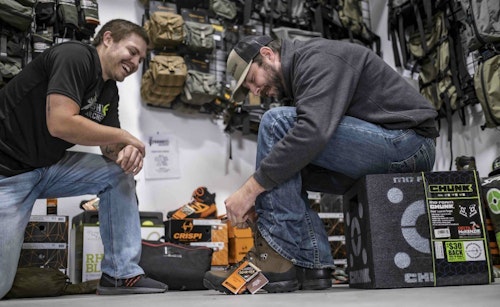Advertising and promotion are big parts of any small business’s success. We all know that. Whether your business is large or small, spending ad dollars wisely is so very important. That means intimately knowing your market, keeping your finger on the pulse of changing market trends both nationally and locally, and targeting your ad spend so you get the most for the least.
Here are some advertising trends, both nationally and locally, that should offer food for the grist mill.
In 2019, U.S. spending on digital advertising surpassed traditional ad spending for the first time ever, according to eMarketer (www.emarketer.com). Mobile advertising accounted for nearly two-thirds of all digital advertising. The advertising industry watchdog group predicts that, by 2023, digital advertising will surpass two-thirds of total U.S. media spending. eMarketer reported that total U.S. media ad spending reached almost $215 billion in 2018, and predicts it will grow to $251.92 billion by 2021.
In what should be no surprise to anybody, Google and Facebook by far collect the most digital advertising revenue — although for the first time, in 2019 the combined share of Google and Facebook actually fell a bit, even as their overall revenues continued to grow — with Amazon a distant third. At the same time, Amazon’s ad business grew more than 50 percent. The 2019 numbers: Google, 37.2 percent; Facebook, 22.1 percent; Amazon, 8.8 percent; Microsoft (and LinkedIn), 3.8 percent; Verizon, 2.9 percent.
Locally, however, there’s a bit of a different picture. According to BIA/Kelsey (www.biakelsey.com), a company that assists traditional and digital media, brands and agencies, and technology companies in local advertising marketplaces, local ad spending continued to grow in 2018 to $151.2 billion, a 5.2 percent increase over 2017. The bulk of those funds were spent on traditional media, with 64.7 percent of expenditures dedicated to legacy media channels like TV and newspapers, with the rest going toward digital channels. The firm reported that direct mail accounted for 25.4 percent of the 2018 local advertising spend, with $38.5 billion spent. Direct mail remains the most popular type of local advertising thanks to response rates of between 3 and 5 percent. Local TV accounted for 13.8 percent of the local ad spend at $20.8 billion, followed by mobile advertising, which garnered $19.0 billion, or 12.6 percent of revenues.
Social media is another digital media channel where platforms have improved ad offerings. “Social channels such as Snapchat and Instagram have evolved their mobile native ad models to include new targeting and reporting features,” said Mark Fratrik, chief economist and senior vice president at BIA/Kelsey, in an interview with eMarketer. And, of course, Facebook and Instagram both continue to be strong local promotional platforms.
A report from Borrell Associates (www.borrellassociates.com ), a consulting company offering insights on what local ad spenders are doing, said that U.S. local digital advertising climbed 9.2 percent to $77 billion, which accounted for 63 percent of all U.S. local advertising. The largest percentage of this digital ad spending — $57.1 billion — came from what’s called “pure play” digital media companies such as Facebook and Google, with the remaining from companies like Autotrader, Craigslist, Zillow, Yelp and other digital media companies. Traditional media companies captured $10.3 billion.
In 2018, Borrell reported that, when it comes to local advertising, digital media pulled in $67.4 billion, print media $27.8 billion, broadcast media (TV, radio) and cable, $24.0 billion, and outdoor, $7.6 billion. However, they report that growth in local digital advertising is expected to have risen 9.2 percent in 2019 and to rise 4.9 percent in 2020, 0.3 percent in 2021, and 0.1 percent in 2022. Borrell’s database includes 10,555 local online operations in the U.S. and Canada. This includes 1,012 daily newspapers and 762 weeklies, 894 local TV stations, 699 multi-station radio market clusters encompassing 3,121 local stations, 2,608 yellow-page directories grouped in 649 multibook market clusters, 182 local cable systems, 1,890 local internet pure-play sites, and 86 other local entities.
Where’s the local digital money coming from? According to Borrell, it’s shifted from directories such as Yellow Pages, which were down some 19 percent in 2019, and traditional print outlets — magazines and newspapers — with a drop of nearly 18 percent. Overall, Borrell reports that traditional media advertising spending fell 45.8 percent in 2019, after a 51.4 percent drop in 2018.

What This Means for You
The trends show where marketers see sales growth potential on a macro level — and that’s with people that are increasingly turning to the internet and mobile devices to research products, services and pricing.
When I lived in Tucson, Arizona, several local gun and hunting shops advertised a lot on local talk radio stations, as well as occasionally in local newspapers. In the small Pacific Northwest town I currently live in, however, the largest gun and hunting shop still advertises regularly in the local newspapers.
What I call indirect marketing also works — that is, being active in the community, supporting charity groups and clubs, sponsoring youth teams, that sort of thing. Building a reputation for over-the-top service and doing whatever it takes (within reason, of course) to satisfy the consumer’s needs, which generates positive word-of-mouth promotion, remains the best and cheapest advertising of all.
Do these ad spending trends affect you? Do you monitor such statistics? How do you effectively promote your own business? What have you found that works well for you, and what have you found to be a waste of time and money? Drop me a note at editor@grandviewoutdoors.com — I’d love to hear from you and share your thoughts with our readers.

Hunting retail store photos by John Hafner






